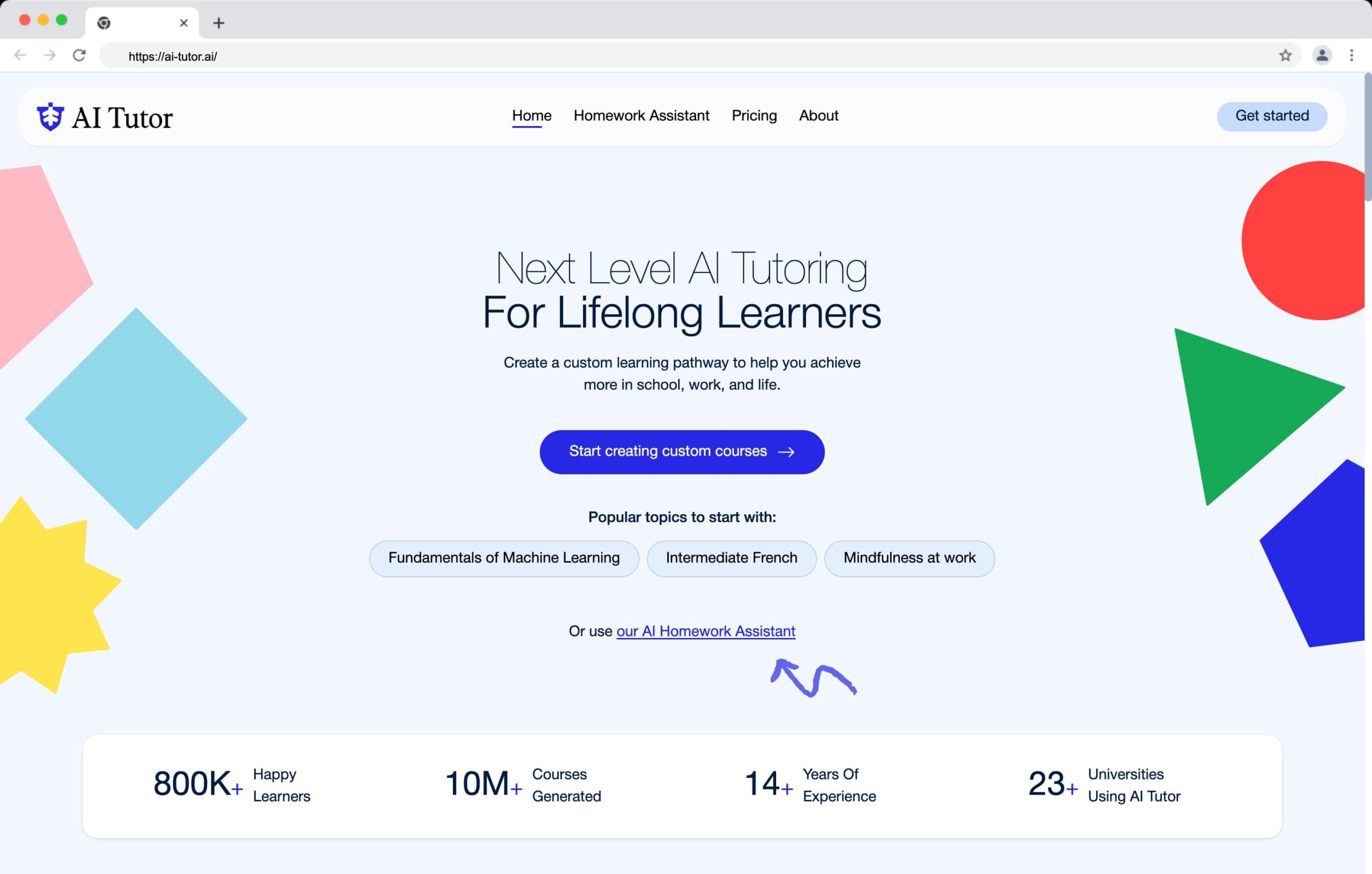AI is changing education, helping teachers save time, reduce workload and improve student outcomes.
From AI powered lesson planning to automated marking and instant feedback, AI tools let teachers focus on teaching rather than administrivia.
But with so many out there, which AI tools help teachers most?
In this post we’ll review the top AI tools for teachers, grouped by use case—with details on how each tool works, key features and benefits.
Let’s get started.
How AI is Changing Teaching
AI is Automating the Boring Bits
Teachers spend hours preparing lessons, grading work and giving feedback. AI helps by automating those tasks so teachers can focus on student engagement.
For example:
- AI lesson generators can create structured lesson plans, quizzes and assignments in seconds.
- AI grading tools can mark student work in seconds, including essays and handwritten answers.
- AI chatbots and tutoring assistants can answer student questions instantly.
Personalised Learning is Now Scalable
AI lets teachers deliver personalised learning to every student.
- Adaptive learning platforms analyses student strengths and weaknesses and adjusts the content accordingly.
- AI powered tutoring tools can explain things in real time so no student gets left behind.
- Automated feedback systems track student progress and suggest recommended study materials.
Reducing Teacher Burnout
By cutting out the tedious bits AI lets teachers:
- Spend more time teaching
- Less admin stress
- Better work life balance
So let’s get onto the best AI tools for teachers.
Best AI Tools for Teachers (By Category)
Top AI tools for education are AI-Tutor.ai for lesson planning, Gradescope for AI-powered grading, Quizizz for auto-generated quizzes, Cognii for AI tutoring, Curipod for interactive presentations, and Otter.ai for real-time transcription.
These tools help Teachers save time, automate tasks and personalise student learning.
AI is no longer a future concept—it’s an everyday tool that’s changing how teachers plan lessons, track student progress and manage classrooms.
Whether it’s automating routine tasks, creating engaging content or providing real-time insights into student learning these AI-powered platforms allow educators to focus on what matters most—teaching.
Below is a breakdown of the top AI tools by category, each designed to boost productivity and student outcomes.
A. AI Tools for Lesson Planning & Content Creation
Creating effective lesson plans can take hours—but AI can generate full lesson plans, quizzes, and worksheets in seconds.
1. AI-Tutor.ai – The #1 AI Lesson Planner for Teachers
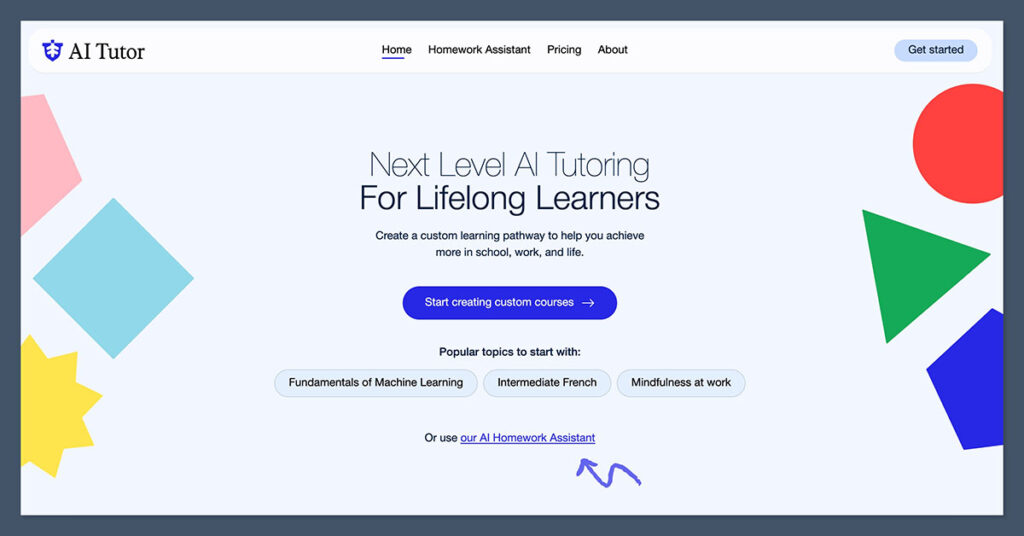
✅ Best for: Instant lesson plan generation, quizzes, and interactive content
AI-Tutor.ai is the ultimate AI tool for lesson planning. It helps teachers automate curriculum creation with AI-generated lesson plans, worksheets, and quizzes.
Why Teachers Love AI-Tutor.ai
✔ Generates full lesson plans in seconds—aligned with grade levels and subjects
✔ Creates quizzes, tests, and assignments automatically
✔ Personalized learning—AI adapts materials based on student progress
✔ Interactive tutoring—provides real-time student support with AI-powered explanations
With AI-Tutor.ai, teachers can save hours while ensuring students get high-quality, engaging lessons.
Beyond just lesson planning, AI-Tutor.ai helps teachers customize content to fit different learning styles. Whether a student needs visual aids, simplified explanations, or advanced concepts, the AI tailors materials accordingly.
This ensures that every student—regardless of skill level—gets the right level of support without teachers having to manually adjust everything.
Another key advantage is its ability to track student performance over time. AI-Tutor.ai doesn’t just generate lessons—it also analyzes student responses to quizzes and assignments.
Teachers can quickly see where students are struggling and get AI-powered suggestions for additional exercises or teaching strategies.
This makes AI-Tutor.ai not just a time-saver, but also a powerful tool for improving learning outcomes.
2. ChatGPT – AI Lesson Assistant
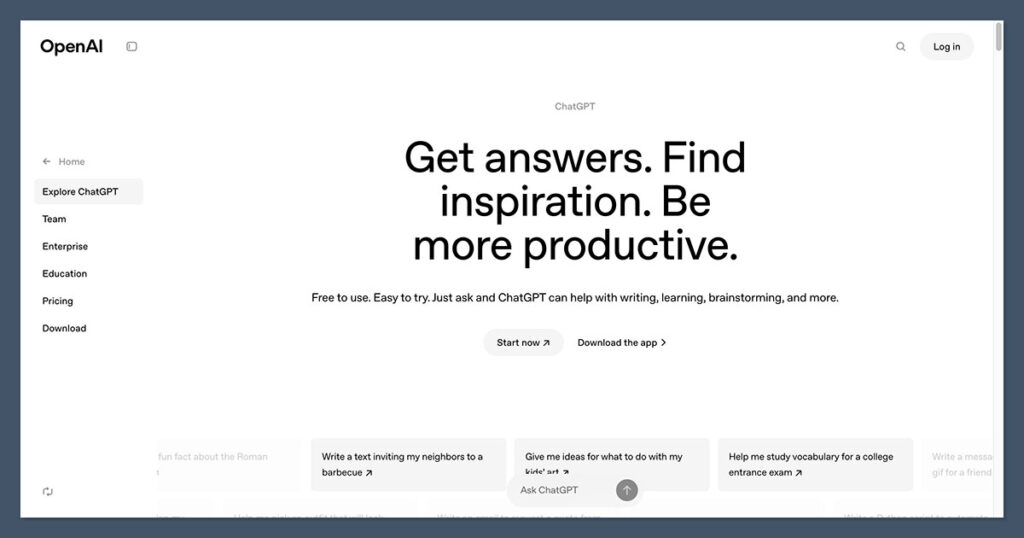
✅ Best for: Generating lesson summaries, simplifying complex topics, and creating discussion prompts
ChatGPT is a powerful AI assistant that helps teachers quickly generate educational content. While it doesn’t specialize in structured lesson plans like AI-Tutor.ai, it’s an excellent secondary tool for enhancing classroom materials.
Why Teachers Use ChatGPT
✔ Generates lesson summaries—quick overviews for students and study guides
✔ Explains complex topics in simplified, student-friendly language
✔ Creates discussion prompts to encourage critical thinking and engagement
✔ Assists with brainstorming lesson ideas and activity suggestions
With ChatGPT, teachers can save time on content creation while ensuring students get clear, well-structured explanations.
Beyond lesson planning, ChatGPT is also a great tool for student support. Teachers can use it to reword difficult concepts in multiple ways, making subjects like math, science, and literature easier to grasp.
It’s especially useful for ESL students, as it can break down lessons into simpler language or even translate key points into different languages.
Another major advantage is instant feedback and idea generation. Need a creative icebreaker, writing prompt, or debate topic? ChatGPT can generate multiple options in seconds.
This allows teachers to focus more on engaging students, rather than spending hours coming up with new materials from scratch.
3. Curipod – AI-Powered Presentations
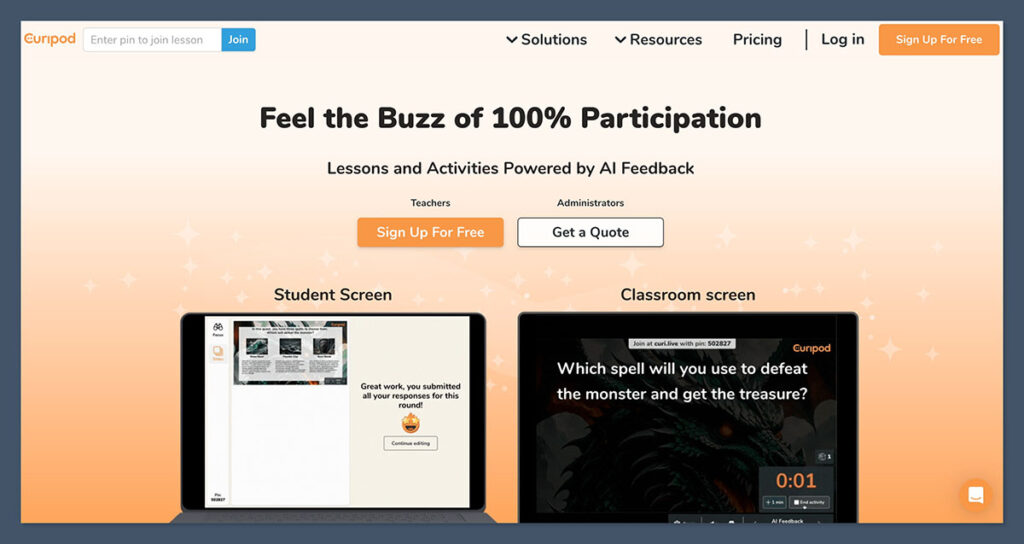
✅ Best for: Automating slideshow creation for interactive and engaging lessons
Curipod is an AI-driven presentation tool that helps teachers instantly generate interactive slideshows. Instead of spending hours designing lesson slides, teachers can input a topic, and Curipod will create visually appealing, structured presentations in seconds.
Why Teachers Use Curipod
✔ Creates AI-generated slideshows with engaging visuals and structured content
✔ Includes interactive elements like polls, quizzes, and discussion prompts
✔ Saves time by eliminating the need for manual slide design
✔ Encourages student participation with dynamic, question-based learning
With Curipod, teachers can make their lessons more interactive without extra effort.
Beyond simple slides, Curipod integrates real-time student engagement features. Teachers can add live polls, word clouds, and brainstorming activities, making lessons more collaborative and discussion-driven. This is especially useful for subjects that benefit from student participation, such as history, science, and social studies.
Another huge advantage is that Curipod adapts to different teaching styles. Whether a teacher prefers lecture-based lessons, flipped classrooms, or project-based learning, Curipod provides customized presentations that align with their approach. This flexibility makes it a go-to tool for any educator looking to enhance their teaching materials.
4. MagicSchool AI – AI Lesson & Quiz Generator
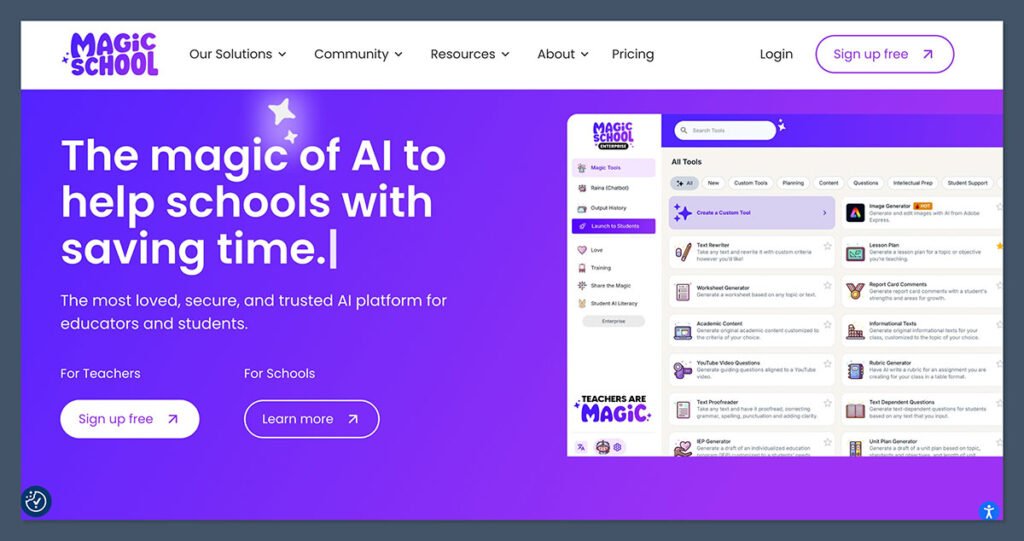
✅ Best for: Creating structured lesson plans, quizzes, and worksheets instantly
MagicSchool AI is an all-in-one AI tool for lesson planning that specializes in generating structured lesson plans, quizzes, and assignments. It’s designed to help teachers create high-quality learning materials in seconds, reducing prep time while maintaining lesson quality.
Why Teachers Use MagicSchool AI
✔ Generates full lesson plans with objectives, activities, and key takeaways
✔ Creates AI-powered quizzes to test student comprehension
✔ Provides structured worksheets tailored to different grade levels
✔ Saves hours of planning time by automating content creation
With MagicSchool AI, teachers can focus more on teaching while ensuring students get organized, engaging lessons.
One of the standout features is its customization ability. Teachers can adjust lesson difficulty, format, and focus areas to fit different student needs. Whether it’s a simplified version for struggling students or an advanced version for gifted learners, MagicSchool AI ensures all students stay engaged at their level.
Additionally, MagicSchool AI integrates with existing curriculum standards, meaning teachers don’t have to worry about lesson alignment. It’s particularly useful for structured subjects like math, science, and language arts, where well-organized lesson plans and assessments are crucial.
B. AI Tools for Automating Grading & Assessments
Grading is one of the most time-consuming tasks for teachers. AI tools now automate grading, feedback, and student performance tracking.
5. Gradescope – AI-Powered Grading Assistant
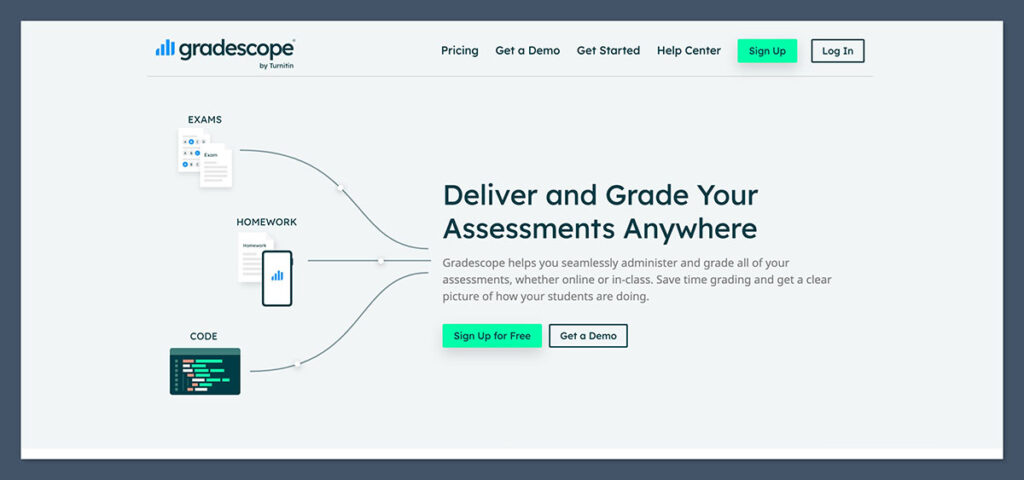
✅ Best for: Automating grading for multiple-choice, essays, and handwritten work
Gradescope is an AI-driven grading tool designed to reduce the time teachers spend on assessments. It uses advanced machine learning to analyze and score student work automatically, making grading faster, more efficient, and more consistent.
Why Teachers Use Gradescope
✔ Scans and grades assignments automatically, even from scanned paper submissions
✔ Works with multiple-choice, handwritten answers, and essays
✔ Provides instant feedback to students for faster learning adjustments
✔ Ensures grading consistency by reducing human bias
With Gradescope, teachers can spend less time grading and more time helping students succeed.
Beyond automation, Gradescope allows teachers to create reusable rubrics, ensuring fair and consistent scoring across all students. Instead of manually grading each response, the AI identifies patterns and applies the rubric accordingly, making the process much faster while maintaining accuracy.
Another major benefit is its ability to handle handwritten work, a challenge for most grading tools. Whether students submit handwritten math problems, essays, or short answers, Gradescope’s AI can interpret and score responses with high accuracy. This is a game-changer for teachers in subjects like English, history, and STEM, where grading is often subjective and time-consuming.
6. Quizizz – Auto-Generated Quizzes & Assessments
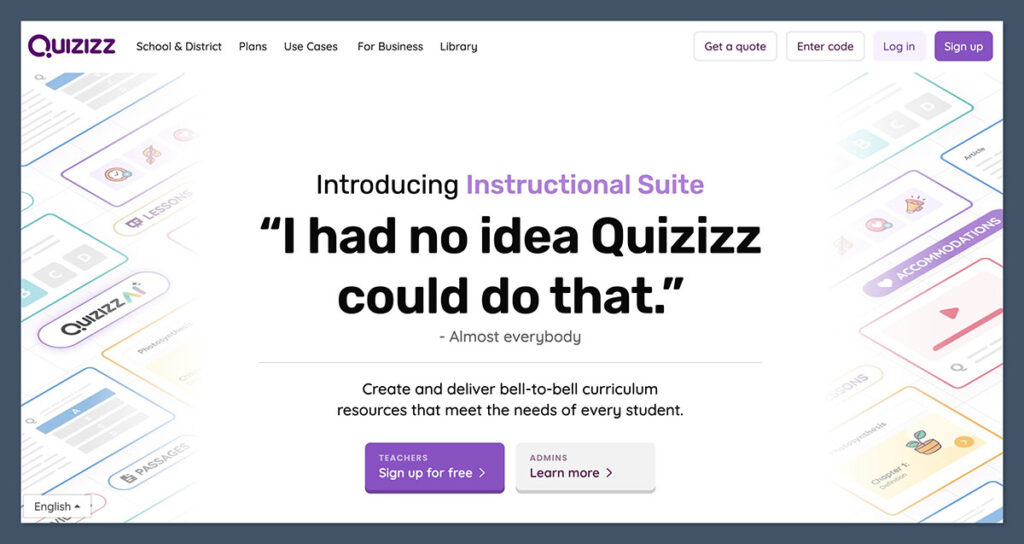
✅ Best for: Creating interactive quizzes with AI-generated questions
Quizizz is an AI-powered quiz platform that helps teachers generate engaging, interactive assessments in seconds. With built-in gamification features, Quizizz makes learning fun and interactive while providing real-time feedback on student performance.
Why Teachers Use Quizizz
✔ Auto-generates quiz questions based on topics, subjects, and grade levels
✔ Includes gamification elements like leaderboards and timed challenges
✔ Provides instant feedback to help students learn from mistakes
✔ Works across devices for easy in-class or remote learning
With Quizizz, teachers can quickly assess student understanding while keeping students engaged.
Beyond simple quizzes, Quizizz personalizes learning by adjusting question difficulty based on student performance. If a student struggles with a topic, the AI adapts by providing easier or additional questions to reinforce learning.
Another standout feature is its detailed performance analytics. Teachers can see which questions students struggle with the most, allowing them to identify knowledge gaps and adjust lessons accordingly.
Whether for quick formative assessments, homework assignments, or review games, Quizizz is a go-to tool for making assessments both effective and enjoyable.
7. Formative – Real-Time AI Feedback
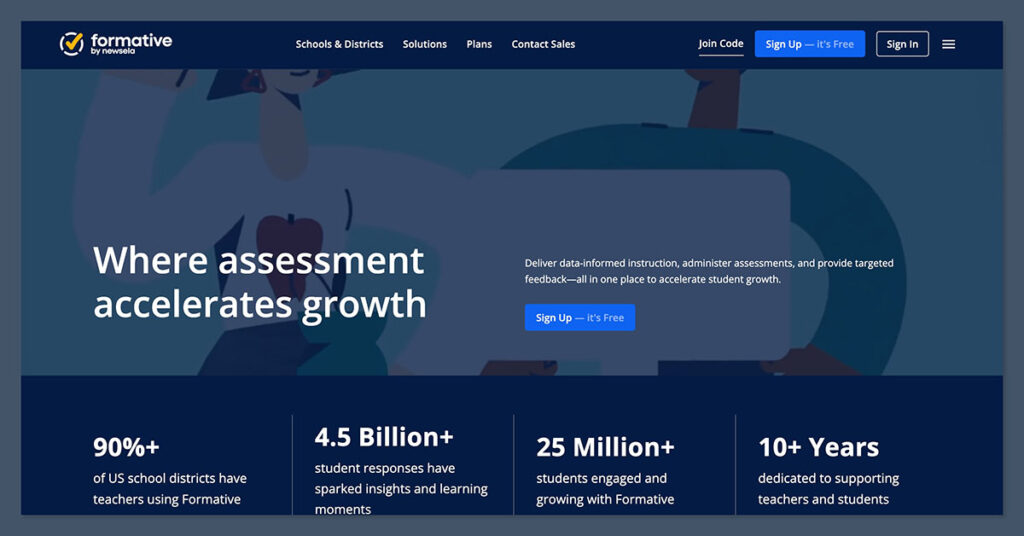
✅ Best for: Monitoring student work live and providing instant feedback
Formative is an AI-powered assessment tool that allows teachers to track student progress in real time.
Unlike traditional grading methods, Formative provides live insights into student responses, helping teachers intervene immediately when students need support.
Why Teachers Use Formative
✔ Enables live student monitoring—see answers as they’re submitted
✔ Provides instant AI-driven feedback to guide student learning
✔ Supports multiple question types, including essays, drawings, and multiple-choice
✔ Integrates with learning platforms like Google Classroom and Microsoft Teams
With Formative, teachers can identify student struggles early and adjust lessons on the spot.
Beyond just grading, Formative acts as a real-time learning assistant, allowing teachers to engage with students while they work.
Instead of waiting until after an assignment is submitted, educators can offer guidance and corrections immediately, preventing students from reinforcing mistakes.
Another key benefit is its customizable feedback system. Teachers can set up auto-grading for objective questions while providing personalized feedback for open-ended responses.
Whether in a physical classroom or a remote learning environment, Formative helps teachers stay connected with student progress at every step.
C. AI Tutoring & Student Support Tools
AI tutoring tools help students learn independently, giving them instant explanations, personalized support, and real-time feedback. This allows teachers to focus on deeper instruction, while AI assistants handle routine questions and reinforcement.
8. ScribeSense – AI Handwriting Reader
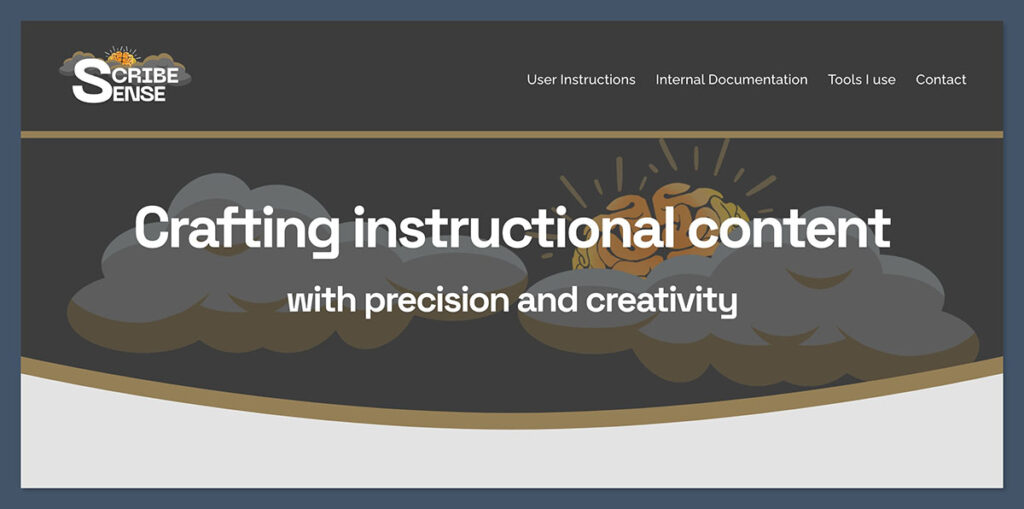
✅ Best for: Scoring handwritten assignments automatically
ScribeSense is an AI-powered grading tool that reads, interprets, and scores handwritten student work. Unlike traditional grading software that only works with typed text, ScribeSense analyzes pen-and-paper submissions, making it perfect for subjects like math, science, and language arts.
Why Teachers Use ScribeSense
✔ Automates the grading of handwritten assignments, reducing manual effort
✔ Supports complex handwriting recognition, including equations and diagrams
✔ Delivers fast and accurate scores, even for large batches of papers
✔ Improves grading consistency, eliminating human bias
With ScribeSense, teachers can save hours of grading time while ensuring fair and accurate assessments.
Beyond grading, ScribeSense helps identify student handwriting patterns, detecting common errors and learning gaps. This allows teachers to provide targeted feedback and offer additional practice where needed.
Another major advantage is its seamless integration with digital grading platforms. Teachers can scan and upload assignments, receive AI-generated scores, and even adjust grades manually if needed.
This combination of automation and teacher oversight makes ScribeSense a powerful tool for both efficiency and accuracy.
9. Cognii – AI Tutoring Chatbot

✅ Best for: AI-driven explanations tailored to each student’s learning style
Cognii is an AI-powered virtual tutor that provides personalized, interactive learning experiences.
Unlike static digital resources, Cognii engages in real conversations with students, helping them understand concepts through guided dialogue and critical thinking exercises.
Why Teachers Use Cognii
✔ Delivers real-time AI tutoring with adaptive feedback
✔ Encourages open-ended responses, improving student reasoning skills
✔ Adjusts explanations based on individual student learning styles
✔ Provides personalized learning paths, reinforcing weak areas
With Cognii, students get instant, tailored explanations, allowing teachers to focus on higher-level instruction.
Beyond just answering questions, Cognii guides students through problem-solving processes, ensuring they grasp concepts rather than memorize answers. This makes it particularly useful for subjects like math, science, and critical thinking-based courses.
Another standout feature is its adaptive learning approach. As students interact with the AI tutor, Cognii analyzes their responses and tailors future explanations accordingly. This ensures that students who struggle with certain concepts get additional reinforcement, while advanced learners can progress at their own pace.
10. Khanmigo (by Khan Academy) – AI-Powered Student Helper
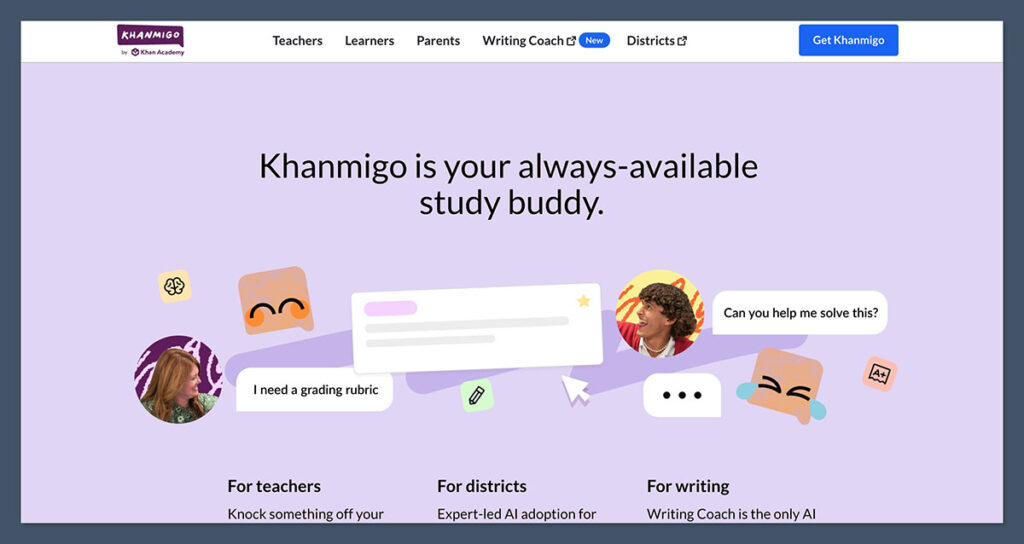
✅ Best for: AI chatbot that guides students through complex problems
Khanmigo is an AI-driven learning assistant from Khan Academy that helps students understand difficult topics through interactive, step-by-step guidance.
Instead of just giving answers, Khanmigo encourages students to think critically, leading them to the right solutions through prompted reasoning and guided explanations.
Why Teachers Use Khanmigo
✔ Guides students through problem-solving, instead of giving direct answers
✔ Supports multiple subjects, including math, science, and humanities
✔ Encourages critical thinking, fostering deeper understanding
✔ Provides instant feedback and hints to keep students engaged
With Khanmigo, students receive AI-powered tutoring, reducing their reliance on teachers for basic questions and clarifications.
Beyond basic tutoring, Khanmigo helps students develop independent problem-solving skills. By prompting students with strategic hints rather than revealing answers, it mimics the Socratic teaching method, making learning more engaging and effective.
Another huge benefit is its seamless integration with Khan Academy’s vast educational content. Students can access step-by-step lessons, practice exercises, and AI-driven feedback—all in one place.
This makes Khanmigo a powerful AI assistant for both self-paced learners and classroom environments.
D. AI Tools for Classroom Management & Productivity
AI isn’t just for lesson planning—it can help teachers stay organized, optimize classroom interactions, and streamline administrative tasks.
These tools assist with lesson planning, student engagement analysis, and transcription, reducing teacher workload and improving overall efficiency.
11. Eduaide – AI Teaching Assistant
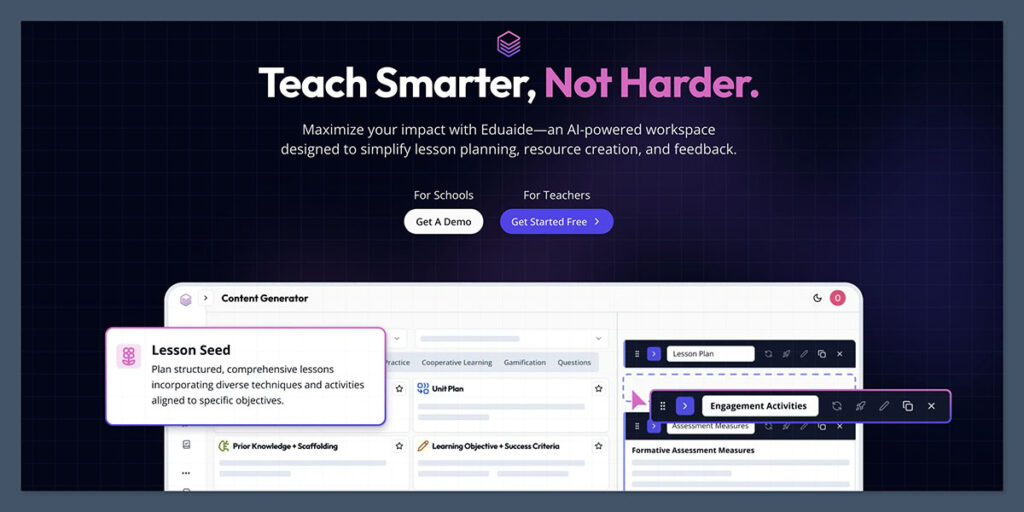
✅ Best for: Organizing lesson plans, tracking student progress
Eduaide is an AI-powered assistant designed to simplify teacher workload management. It helps educators organize lesson plans, track student performance, and streamline assessments, making it easier to stay on top of classroom responsibilities.
Why Teachers Use Eduaide
✔ Organizes and structures lesson plans, keeping teaching materials in one place
✔ Tracks student progress, identifying strengths and areas for improvement
✔ Automates assessment creation, reducing manual grading work
✔ Supports multiple subjects and teaching styles, making it highly adaptable
With Eduaide, teachers can spend less time on administrative tasks and more time engaging with students.
Beyond simple organization, Eduaide analyzes student performance trends, providing valuable insights that help teachers adjust their instructional strategies.
If certain students struggle with specific concepts, the AI can suggest personalized interventions, ensuring no one falls behind.
Another standout feature is its collaborative functionality. Teachers can share lesson plans, assessments, and student progress reports with colleagues, making team-based teaching and departmental planning much more efficient.
Whether used in traditional classrooms or remote learning environments, Eduaide helps teachers stay organized and effective.
12. TeachFX – AI for Classroom Discussion Analysis

✅ Best for: Analyzing teacher-student interactions to improve engagement
TeachFX is an AI-driven tool that records and analyzes classroom discussions, helping teachers measure student participation and improve engagement strategies.
It provides data-driven insights into how much time students spend speaking versus listening, allowing educators to adjust their teaching styles accordingly.
Why Teachers Use TeachFX
✔ Analyzes student and teacher talk time, promoting balanced discussions
✔ Provides insights on engagement levels, ensuring all students participate
✔ Helps improve questioning techniques, fostering deeper learning
✔ Supports professional development, allowing teachers to refine their teaching methods
With TeachFX, teachers get valuable data on classroom dynamics, helping them create more inclusive and interactive lessons.
Beyond just tracking participation, TeachFX identifies patterns in classroom discussions, highlighting areas where teachers can encourage more student involvement. For example, if the data shows that only a few students are actively speaking, the AI can suggest strategies to involve quieter students, ensuring a more equitable learning environment.
Another key benefit is its role in professional development. By reviewing their own teaching patterns, educators can refine their questioning techniques, improve how they facilitate discussions, and create a more engaging learning experience.
This makes TeachFX a powerful tool for both new and experienced educators looking to enhance their teaching effectiveness.
13. Otter.ai – AI Transcription for Notes & Meetings
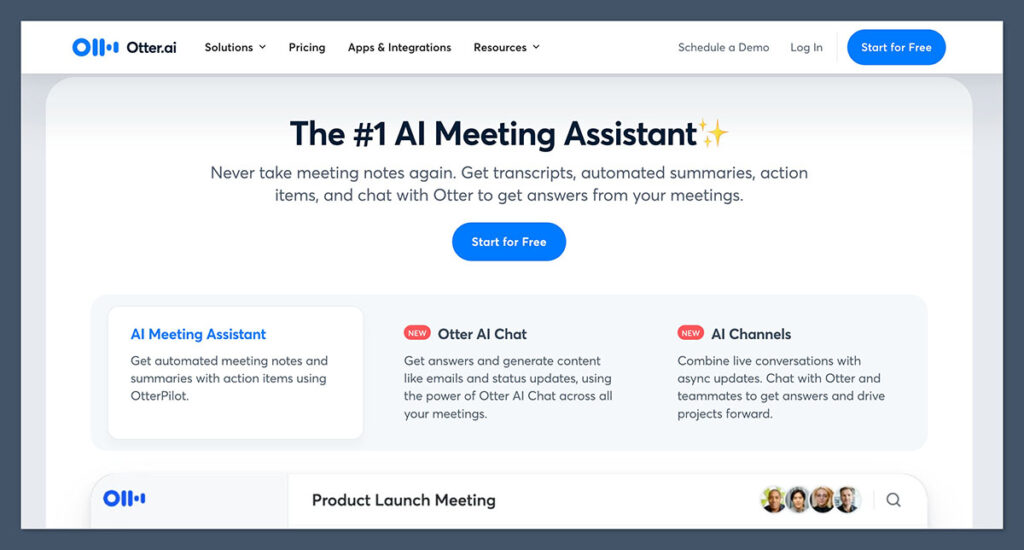
✅ Best for: Real-time transcription for lectures, teacher meetings, and student discussions
Otter.ai is an AI-powered transcription tool that automatically converts spoken words into written text, making it a game-changer for teachers who need accurate lecture notes, meeting transcripts, or student discussion records.
Why Teachers Use Otter.ai
✔ Automatically transcribes lectures and discussions, saving time on note-taking
✔ Creates searchable transcripts, making it easy to review key points
✔ Helps students with disabilities by providing text-based versions of spoken content
✔ Supports collaboration, allowing teachers to share meeting notes with colleagues
With Otter.ai, teachers can focus on teaching instead of manually taking notes, ensuring every important detail is captured.
Beyond simple transcription, Otter.ai includes speaker identification and timestamping, making it easier to organize and review transcripts.
This is especially useful for professional development sessions, parent-teacher conferences, and student presentations, where keeping a written record can enhance communication and planning.
Another major benefit is its support for accessibility. Students with hearing impairments or learning disabilities can use Otter.ai to access written versions of lectures, ensuring they don’t miss out on key information.
Whether used for classroom recordings, faculty meetings, or study group discussions, Otter.ai is an essential tool for educators looking to streamline documentation and improve accessibility.
E. AI-Powered Research & Professional Development
For teachers who need academic research support and professional growth, these AI tools are game-changers.
They help find credible sources, summarize research, and create engaging educational content, saving educators valuable time while improving lesson quality.
14. Elicit – AI Research Assistant
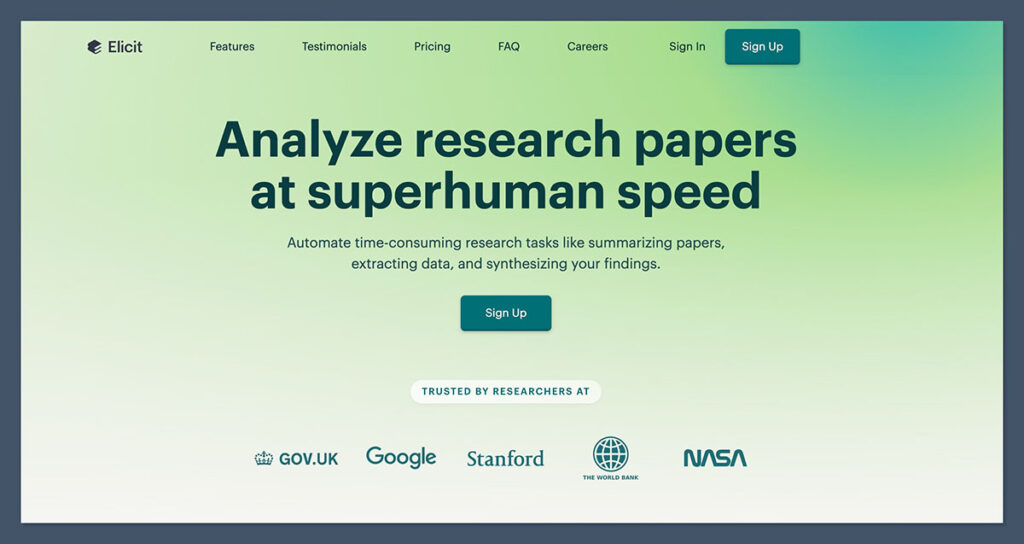
✅ Best for: Finding academic papers, summarizing research
Elicit is an AI-powered research assistant that helps teachers quickly find, analyze, and summarize academic papers.
Instead of spending hours searching for reliable sources, Elicit automates the process, delivering high-quality research insights in seconds.
Why Teachers Use Elicit
✔ Finds peer-reviewed academic papers instantly, saving research time
✔ Summarizes complex research articles, breaking them down into key points
✔ Provides AI-generated insights, helping teachers connect research to lesson plans
✔ Supports multiple subjects, making it useful for all educators
With Elicit, teachers can access relevant research faster, ensuring their lessons are backed by credible, up-to-date information.
Beyond just finding papers, Elicit analyzes trends in research, allowing teachers to identify new educational strategies based on real data. Whether it’s exploring the latest in cognitive science, instructional techniques, or classroom management, Elicit makes it easy to stay informed without digging through countless academic databases.
Another huge benefit is its ability to generate citations and references automatically. Teachers can quickly compile source lists for presentations, research papers, or lesson materials—ensuring that students are exposed to fact-based, well-sourced information.
15. Perplexity AI – AI Search Engine for Educators
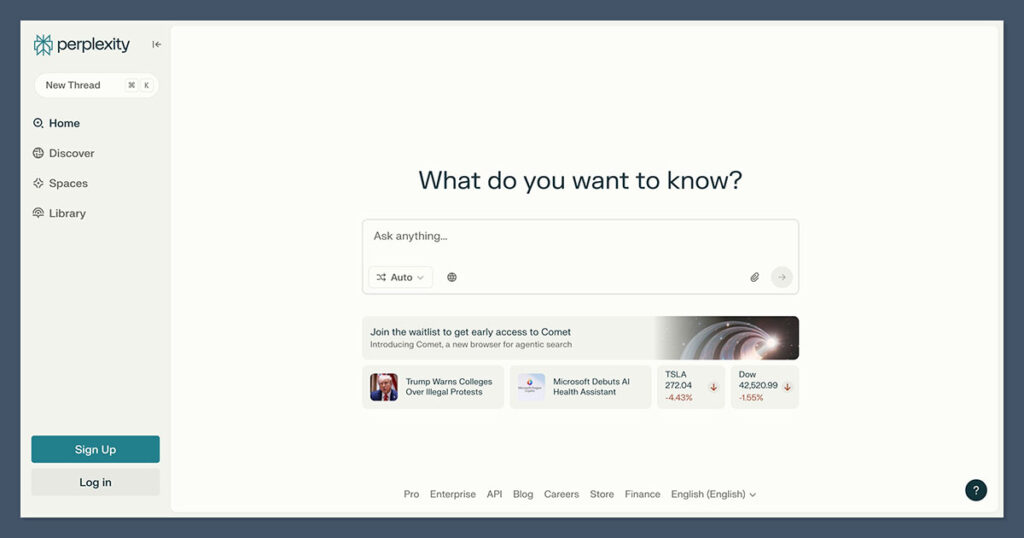
✅ Best for: Conducting detailed, reliable educational research
Perplexity AI is an advanced AI-powered search engine that helps teachers find accurate, in-depth answers to complex educational queries.
Unlike traditional search engines, Perplexity AI analyzes multiple sources at once, summarizing key information and providing context-rich explanations.
Why Teachers Use Perplexity AI
✔ Delivers highly detailed, fact-checked responses in seconds
✔ Summarizes multiple sources into clear, concise answers
✔ Helps teachers find new teaching strategies and educational research
✔ Reduces misinformation by cross-referencing reliable sources
With Perplexity AI, educators can quickly access trustworthy information, making lesson planning and research more efficient.
Beyond just search, Perplexity AI acts as a knowledge assistant, allowing teachers to ask open-ended questions and receive detailed, structured responses.
Instead of sorting through multiple web pages, teachers get direct, accurate answers—perfect for research-heavy subjects like history, science, and philosophy.
Another standout feature is its ability to process long-form documents and summarize them. Whether it’s an educational report, a policy document, or a scientific study, Perplexity AI can extract key points, helping teachers quickly digest and apply new information to their lessons.
16. Adobe Firefly – AI for Educational Content Creation

✅ Best for: Creating AI-generated images, videos, and infographics for lessons
Adobe Firefly is an AI-powered content creation tool that allows teachers to generate high-quality visuals, graphics, and videos for their lessons.
Whether educators need custom illustrations, engaging infographics, or interactive media, Firefly makes it easy to create professional-grade content without graphic design skills.
Why Teachers Use Adobe Firefly
✔ Generates AI-powered visuals tailored to educational topics
✔ Creates infographics, charts, and illustrations for classroom materials
✔ Enhances presentations with high-quality graphics
✔ Saves time on content creation, allowing teachers to focus on lesson delivery
With Adobe Firefly, teachers can bring their lessons to life, making complex topics more engaging and visually appealing for students.
Beyond just creating images, Adobe Firefly is particularly useful for visual learners. Many students retain information better when presented with graphics, and Firefly allows teachers to customize visuals to match specific lesson objectives.
Another major advantage is its ability to generate multiple content types. Whether teachers need an animated explainer video, a set of interactive flashcards, or a visually rich presentation slide, Firefly provides customized, high-quality assets—all with just a few clicks. This makes it a powerful tool for modern, multimedia-driven classrooms.
The Pros & Cons of AI in Teaching
AI is transforming education by automating tasks, personalizing learning, and reducing teacher workload. However, like any technology, it comes with both benefits and challenges. Here’s a balanced look at the pros and cons of AI in teaching.
Pros of AI in Teaching
- ✔ Saves time – AI automates grading, lesson planning, and administrative tasks, allowing teachers to focus on instruction instead of paperwork.
- ✔ Improves student learning – AI-powered platforms adapt lessons to individual student needs, ensuring that each student learns at their own pace.
- ✔ Reduces teacher stress – With AI handling routine tasks, teachers experience less burnout and can dedicate more energy to student engagement and creative teaching methods.
With AI-powered tools, educators can increase efficiency, improve learning outcomes, and create a more personalized teaching approach.
Beyond just saving time, AI allows teachers to identify student learning gaps faster. Adaptive AI systems analyze student performance in real-time, offering instant feedback and personalized study recommendations.
This means struggling students get the extra support they need, while advanced learners can move ahead at their own pace.
Another key advantage is accessibility. AI-powered tools support diverse learning needs, including students with disabilities.
Text-to-speech, automated captions, and adaptive learning platforms help make education more inclusive, ensuring that every student has the resources they need to succeed.
Cons of AI in Teaching
- AI bias – AI models are trained on existing data, which can sometimes result in biased or inaccurate content. Teachers need to review AI-generated materials to ensure fairness and accuracy.
- Technology dependence – Not all schools have equal access to AI tools due to budget constraints or lack of infrastructure. This can create a digital divide between well-funded and underfunded schools.
- Data privacy concerns – AI tools often collect student data, raising concerns about how that data is stored, used, and protected. Schools must ensure that AI tools comply with privacy regulations.
While AI can be a powerful tool for education, it’s important for teachers to use it strategically to enhance—not replace—traditional teaching methods.
One of the biggest concerns with AI in education is over-reliance on technology. If students become too dependent on AI-generated answers, they may lose critical thinking skills. Teachers must strike a balance, using AI to support learning while still encouraging independent thought and problem-solving.
How to Use AI Responsibly as a Teacher
To maximize the benefits of AI while avoiding potential risks, teachers should follow these best practices:
- Use AI as an assistant, not a replacement – AI can help with lesson planning, grading, and tutoring, but it should never replace human instruction.
- Double-check AI-generated lesson plans for accuracy – AI tools can sometimes generate incorrect or misleading information, so teachers should always review and refine content before using it in class.
- Encourage students to think critically instead of relying entirely on AI – Students should use AI as a learning tool, not just for quick answers. Teachers can design assignments that require students to analyze, evaluate, and apply AI-generated content, fostering higher-order thinking skills.
With the right approach, AI can enhance education while preserving the creativity, intuition, and personal connection that great teachers bring to the classroom.
Another key responsibility is teaching students about AI literacy. As AI becomes more prevalent, students need to understand its strengths and limitations.
Educators should discuss ethical concerns, potential biases, and responsible AI usage, preparing students for a tech-driven future.
Conclusion & Next Steps
AI is changing education by helping teachers save time, grade faster and personalize learning. When used right AI can help with lesson planning, student engagement and reduce teacher workload making classrooms more efficient and fun.
But AI is not a replacement for teachers. The best way is to use AI as a support system—a tool that streamlines tasks, makes learning more effective and gives deeper insights into student progress.
🚀Want to try AI in your classroom? Start with AI-Tutor.ai, the #1 AI tool for lesson planning and create high quality lesson plans in seconds.
By using AI wisely and responsibly teachers can get the most out of it and keep human creativity, empathy and critical thinking at the heart of education.
